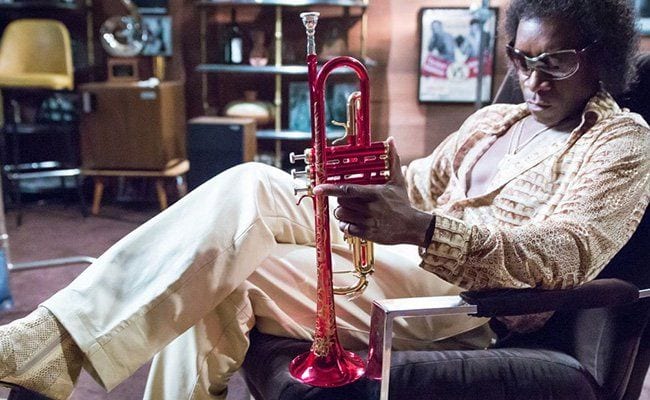
“I understand all of this playing, but then it stops. There’s this hole in this story and I want to talk about that hole and what’s going in that hole and how do you get in that hole and how do you get out of that hole and what does it look like to get out of that hole?”
From late 1975 (maybe 1976) through the middle of 1980, Miles Davis stopped recording and performing. Some people call this period “the lost years”, others, including Don Cheadle, “the hole”. As the time remains mystifying to Davis scholars and fans, it continues to generate speculation. When, in 1981, he reemerged from his brownstone on West 77th Street, with a new label, a new record, and a new marriage to Cicely Tyson, he may as well have been reborn.
As glad as fans might have been to have access to another decade’s worth of innovations, still many people wonder to this day, what was he doing? And why was he doing it? Don Cheadle’s movie, the not-a-biopic Miles Ahead, imagines answers to these questions. These answers range from likely to unbelievable, provocative to exasperating, scenarios premised on his well-known addictions and some lesser-known obsessions, while also looking ahead to changes he made, in style and performance, on that reemergence.
The movie opens with an interview, Miles sitting down with a fictional Rolling Stone reporter named Dave (Ewan McGregor). Miles wields his red trumpet like a weapon, or a shield. The relationship is instantly tense, Miles seated at a distance from the reporter, who’s off-screen. “When you’re creating your own shit,” Miles says, his voice as raspy as you expect. “Man, even the sky’s not the limit.”
The observation holds for all that follows, as the film flashes back to his meeting with Dave, then careens from idea to idea, from possibility to possibility, imagining Miles caught up with drug dealers and gangsters, guns and cars and a lousy contract with CBS Records. You understand that this version of Miles is frustrated and aggressive, that he’s desperate for cocaine and also, in flashbacks, for the wife who’s left him, Frances Taylor (Emayatzy Corinealdi). Beset and yet yearning to make music, this movie’s Miles is full of promises and surprises.
Even as the plot turns increasingly unwieldy and strange, the film reveals the limits of its own creation. Many years in the making, as Cheadle worked to get it funded and distributed, Miles Ahead deploys clichés and corniness. These start with Dave’s very existence, and grind on with his erratic behaviors, sometimes frantic, sometimes maybe-moved by the art he seeks to expose. Dave is a concoction, exaggerated in a way that hints at his origins, that is, as the requisite white guy, the means by which Miles’ story is twisted into a buddy movie.
As Cheadle puts it to David Fear, a nonfictional Rolling Stone reporter, “To get this film financed, we needed a white co-star. And until Ewan came on, until we had cast the proper white co-star, there was no Miles Davis movie. There was no Miles Ahead. That means something. That’s the reality.”
Ponder this reality for a moment. Don Cheadle needs a white co-star to make a movie about Miles Davis.
It’s a reality that shapes the idea of the hole, both in Miles’ own experience and in its imagining here. Think of the losses this hole represents, the trauma it produces. In picturing the hole, Miles Ahead makes art, fictionalizes and reorders that reality. Miles treats Dave like the prop he is. “You’s a crazy white motherfucker,” he observes, while you know what Miles may or may not know, that Dave is cheating him, doing his best to manipulate and get over on him. With Dave along for the ride, the movie careens into alleys it can’t quite navigate, fanciful turns of events that take Miles and his white buddy from one location to another, a gangster car chase that results from Miles trying to recover the one and only copy of some as yet unreleased music.
If these fantasies are generally distracting — in particular from the excellent bouts of music the film also offers — one considers more profound effects of the reality on Miles, in his lost relationship with Frances.
The film is smart enough to avoid asserting answers concerning the hole. But it takes up the ways Frances (whom he abuses here emotionally and physically) might have haunted Miles, apart from the two album covers she graced, Someday My Prince Will Come and E.S.P.. Seeing him with her in Miles’ memories, which hardly paint him as the hero, you’re exposed to the pain that he feels and also that he inflicts. Apart from his relentless womanizing, Miles takes out his frustrations with everyone and with his own disappointments on her.
Again and again, Frances shows remarkable resilience, articulating his depths of his art and hers, the reasons they express themselves and share that expression with the world. “When that thing happens,” she says, walking from their bed and beginning to dance, “you don’t breathe, they don’t breathe, you’re just holding them up, then we fly.”
In this brief scene, exquisite and poignant, Miles watches Frances, as you watch them both. You might be breathing, but you’re not aware of doing so. The breakdown of love and trust that follows this scene is inevitable, but for this moment, the utter necessity and brutal costs of art are entirely clear.


